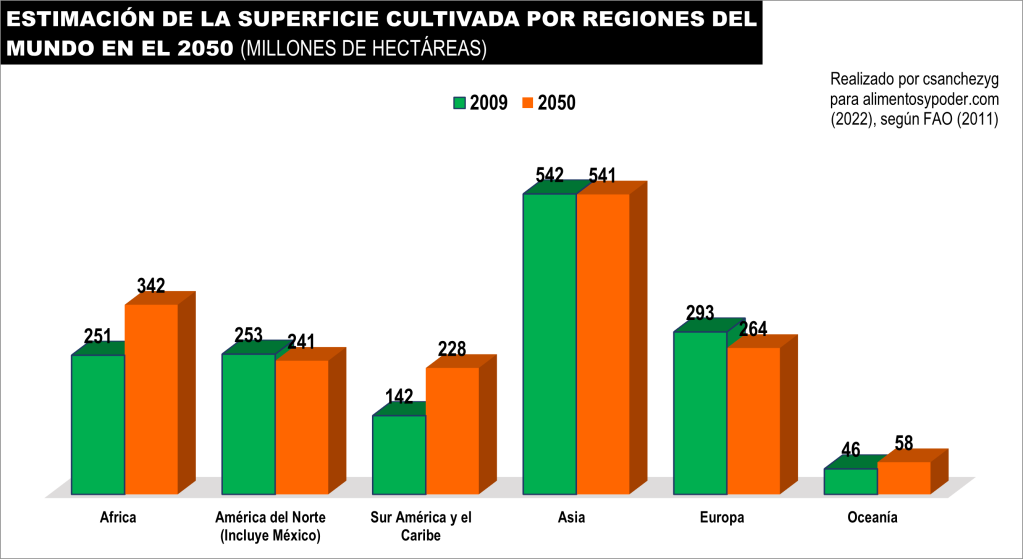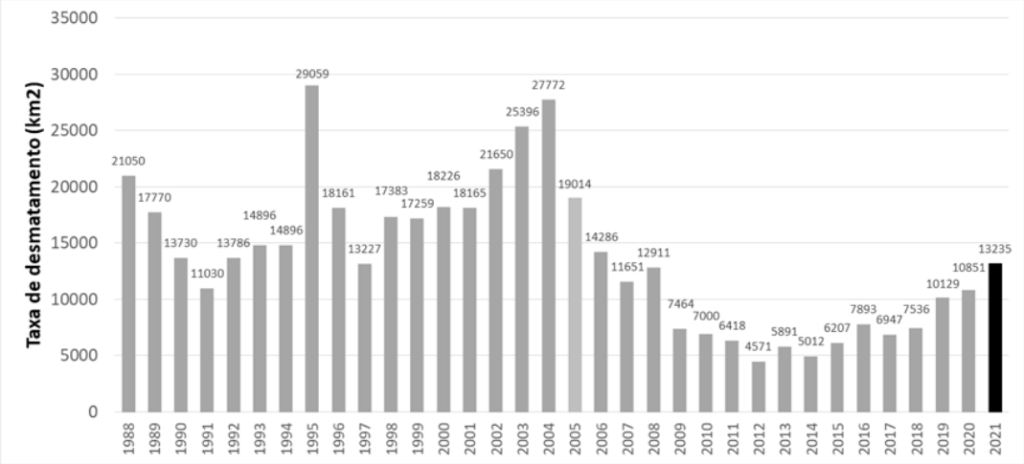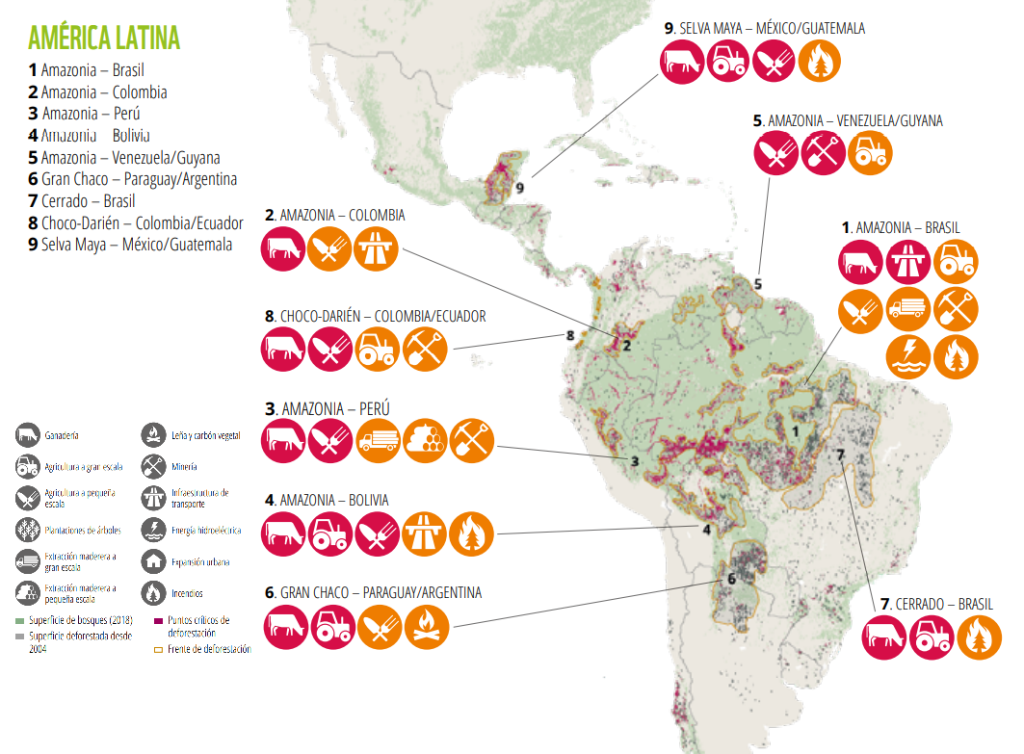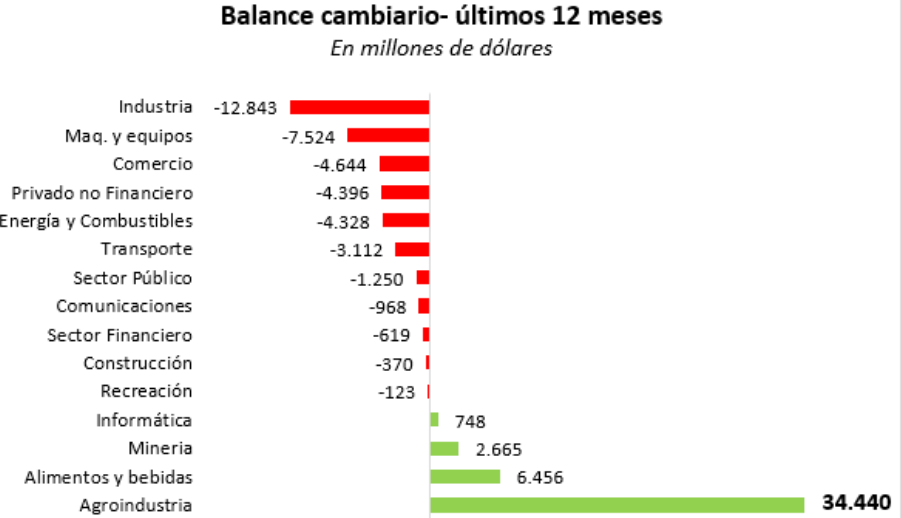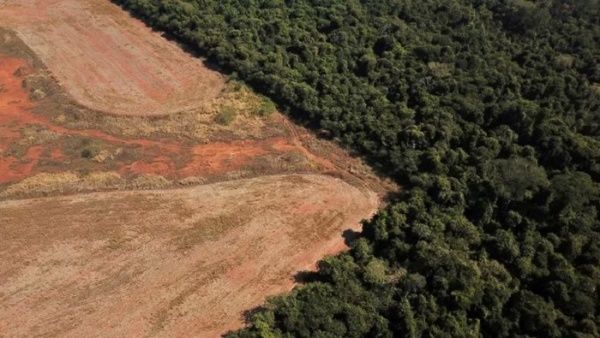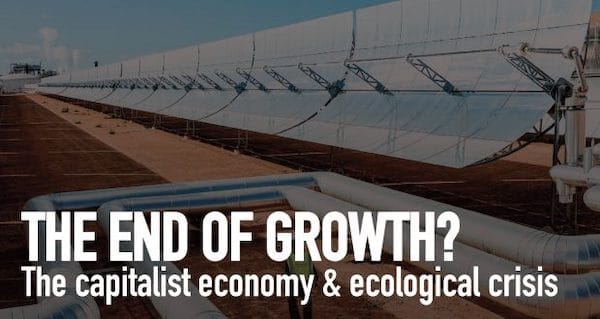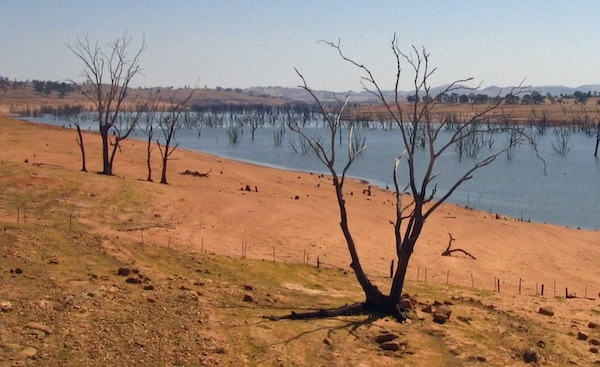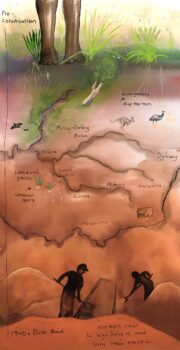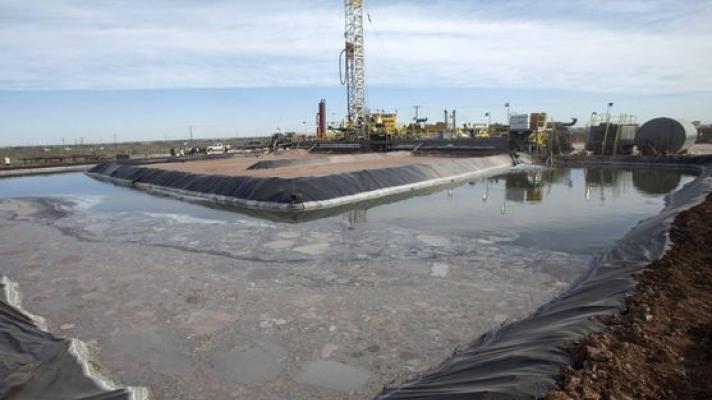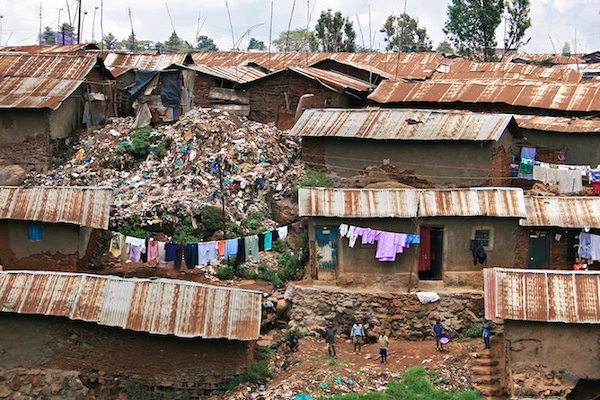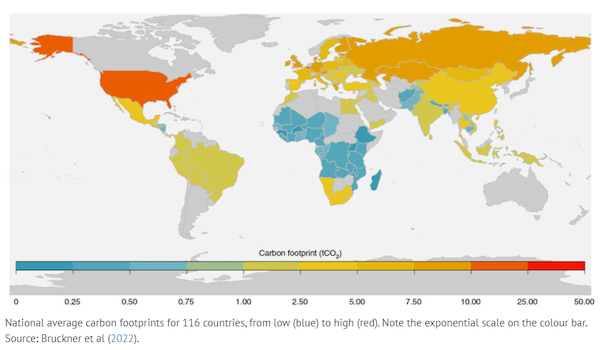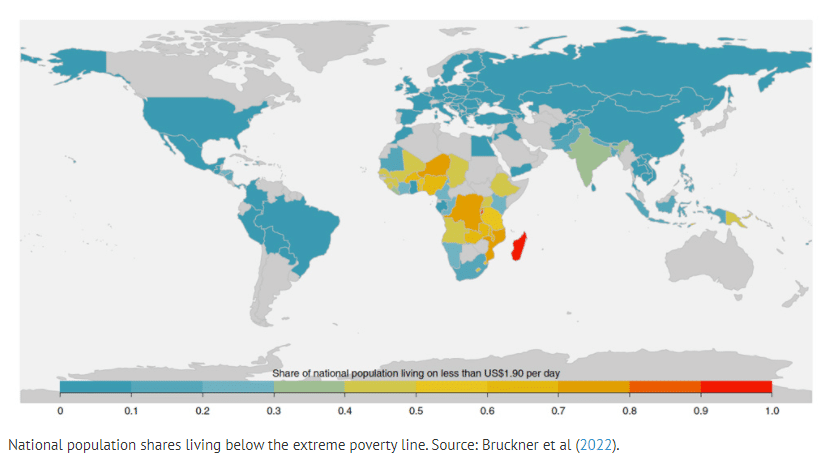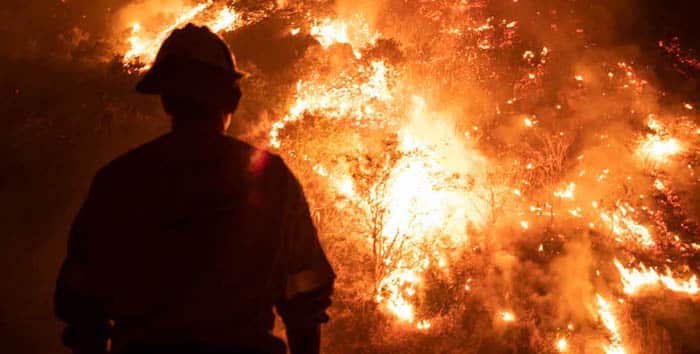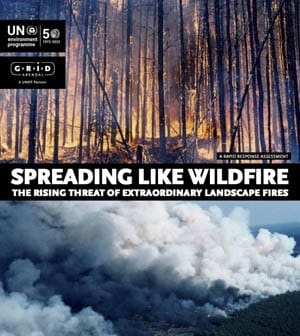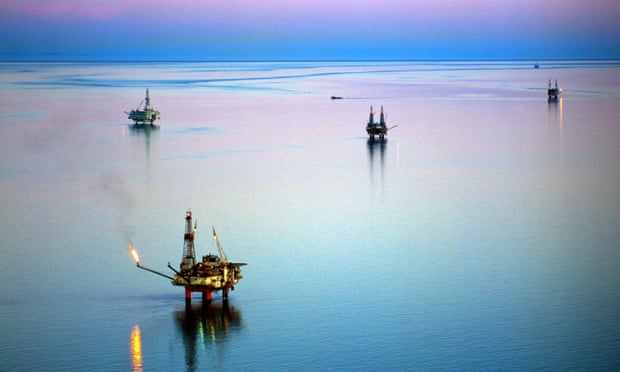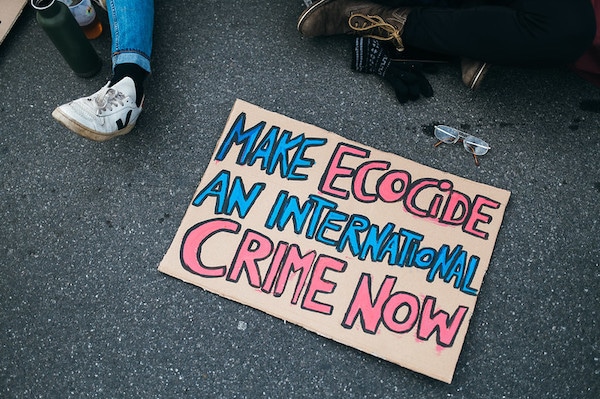
“Make Ecocide An International Crime Now” sign on the tarmac at a rally against climate change. (Photo: Ivan Radic / Flickr)
Ecocide or Socialism?
Posted Jan 29, 2022 by Victor Wallis
[published in Italian translation in Menelique (www.menelique.com), No. 6, November 2021; posted here with permission.]
Ecocide–the destruction of the entire ecosystem–is a real prospect. Its possibility has been well known to scientists since the 1980s, if not earlier. Every projection of its pace has under estimated the actual rate of breakdown.
I
It has been widely known since 2015 that the petroleum companies were informed by their own scientists, in the 1970s, that the combustion of fossil fuels would lead to global warming. However, not only did they continue to expand oil production; they undertook a deliberate campaign–especially in the United States–to discredit climate science in the public imagination.
Capitalist ecocide is thus not simply a matter of negligence; it is the result of a criminal disposition–one which, true to capitalist form, consciously subordinates the wellbeing of humanity and nature to the dictates of profit.
At present, the signs of breakdown have already attained calamitous proportions. New records of high temperatures are set every year. The associated droughts and forest fires further escalate the speed at which carbon dioxide is spewed into the atmosphere and at which biodiversity is broken down. Glaciers are melting, sea levels are rising, oceans are warming, storms are intensifying, and marine life is now threatened not only by pollution and over-fishing, but also by suffocation from de-oxygenation of the waters (climateandcapitalism.com). Meanwhile, tropical forests are in some cases (as in Brazil) being deliberately destroyed, while in others they are subject to a “green-grabbing” process which expels the indigenous populations that have helped sustain them (www.ispionline.it).
Can private and corporate capital sponsor a solution to the crisis it has engendered? It is not even making a serious effort. That is why, as a matter of survival, we need a socialist framework informed by ecological awareness–that is, ecosocialism.
II
Perhaps the most common objection to socialism raised by those who understand the severity of the crisis, is that although a socialist framework may be desirable, we cannot afford to wait for the arrival of socialism before addressing the environmental threat.
It is true that the environmental danger requires immediate steps, and it’s true that we cannot immediately expect a socialist transformation. But it does not follow that the necessary near-term steps can be taken without being informed by an understanding that is at least implicitly socialist.
The best way this can be seen is if we observe that the proposals that are put forward within a capitalist framework invariably limit themselves to calling for “clean energy.” They do not call for reducing the total amount of energy used. Nor do they call for reducing the total amount of materials used in production, nor do they call for reducing the amount of space that is withdrawn from biodiverse ecosystems.
For example, Joe Biden has decreed that by 2030 at least half of all cars sold in the U.S. should be powered by electricity, but he has not proposed that the number of private cars should be reduced–as it could and should be–to a small fraction of its present level. Even if we suppose that the electricity to power the new cars is generated without using fossil fuels, there remains the problem that the total number of vehicles will, in the absence of restraint on “market forces,” tend to increase. This will in turn mean that more metal will have to be mined, and more green space will be paved over.
Consider also the fact that, not only for electric batteries but also for communications devices (and of course for weapons systems), there will be a continuing demand for rare metals (climateandcapitalism.com; www.conceptmanagement.co.uk), and that all additions to the total stock of needed metal (i.e., beyond what can be obtained from recycling) require mining processes that, much like fracking, are disastrous for natural water supplies–as for example in the case of gold (used in computer chips), for which toxic cyanide is driven deep into the ground to separate it from the rock in which it is found.
The assumption of a continuously rising energy demand also leads–given the limitations of solar and wind power–to advocacy of nuclear power, which, in addition to all its other costs and dangers, wastes a prodigious amount of water. (For a concise yet comprehensive analysis of nuclear power, taking into account its complete life-cycle and also the increasing risk of nuclear power plants being damaged by catastrophic climate events, see climateandcapitalism.com).
In short, it is not possible to escape the conclusion that even a limited reversal of the dangerous environmental trends requires that we drastically reduce economic activities that do not serve basic human needs.
Reducing economic activities is not part of the capitalist lexicon. To carry out such a reduction in a planned way–respecting human needs–is indeed possible only within a framework no longer driven by market-competition and accumulation. However, some of the local or immediate components of such an approach can be initiated at any time and, as they gain traction, can lay the foundations of the new culture that will have to come into being–across the whole of society–if the socialist approach is to take root.
One example of such initiatives is the planting of urban gardens. Another is the creation of farmers’ markets. Yet another is resistance to specific capitalist aggressions like the installation of oil pipelines. Community involvement requires educational steps, which can lead to radical rejection of a whole approach to defining economic priorities. A remarkable example of such a process unfolded recently in El Salvador, which, as the result of a long struggle of peasants against the destruction of their aquifers by a Canadian mining company, became “the first country of the world to ban all mining” (whowhatwhy.org).
Ultimately, it is indispensable to have a regime that dedicates itself to the protection of biodiversity. But the breadth of support mobilized by the Salvadoran peasants points to the thoroughness with which, if such a regime is to emerge, ecological awareness must already permeate the entire society, overcoming resistance that might previously have been considered insurmountable.
III
Once such a regime–grounded in ecosocialism–is in place, its strategy will depend on the particularities of any given society. But a population that has come to recognize the priority of biodiversity over expanded manufacture will be prepared to engage in the kinds of discussion that will be needed in order to determine which sectors of economic activity (including services) will need to be retained or expanded and which ones will need to diminished or phased out entirely.
The guiding principle for such deliberation will be the extent to which a given activity responds to some basic human need (whether physical or psychological), as opposed to being of service simply to advancing the interests of capital–e.g., through excess production, sales-promotion, financial speculation, environmentally harmful technologies, or, most especially, the maintenance of a vast enforcement apparatus charged with protecting the global interests of the capitalist class. (For fuller discussion, see my 2001 article “Toward Ecological Socialism” [www.researchgate.net], reprinted in my book Red-Green Revolution: The Politics and Technology of Ecosocialism [Toronto: Political Animal Press, 2018].)
A regime that can elicit and enforce this basic distinction offers the only hope for holding back the forces that threaten our common survival.
https://mronline.org/2022/01/29/ecocide-or-socialism/
******************************
Near New Orleans, weak regulations cause oil pipeline to leak 300k gallons
Cecilia PazJanuary 29, 2022
Download PDF flyer https://flyer-generator.herokuapp.com/? ... sts/101527
On Jan. 12, federal documents revealed an oil spill of more than 300,000 gallons, which was discovered just east of New Orleans on December 27, 2021.
An inspection in October revealed severe corrosion along the exact 22-foot pipeline section where the spill occurred, yet repairs were delayed in compliance with criminally negligent federal regulations. The 42-year-old pipeline that ruptured is operated by Collins Pipeline Co., which is co-owned by the Valero and PBF Energy corporations, both of which receive hundreds of millions of dollars in government subsidies yearly.
The Pipeline and Hazardous Materials Safety Administration reports that the diesel spill occurred in St. Bernard Parish near a levee along the Mississippi River Gulf Outlet Canal between Chalmette and Bayou Sauvage National Wildlife Refuge.
Despite Biden’s promises of implementing the biggest climate investment in U.S. history, the state and federal government continue to serve oil companies. Bare-minimum federal regulations are responsible for this spill because they allowed the neglect of essential pipeline repairs. Nearly all oil pipelines leak; upwards of 350 oil spills occurred in Louisiana after Hurricane Ida alone.
“The recent spill in St. Bernard Parish is an abject example of Louisiana regulators’ cozy relationship with industry, defined by a desire to facilitate and promote industrial activity rather than protecting residents and the environment,” said Jack Reno Sweeney of the Louisiana Bucket Brigade — an organization which partners with and advocates for communities impacted by petrochemical pollution — to Liberation News. Sweeney emphasized the “lack of immediate communication with those most affected, local residents and workers in the seafood industry, after the spill was discovered.”
The Associated Press reports that “most” of the spill was cleaned up, yet only 50,000 gallons, one-sixth of the damage, have been recovered.
The environmental impact
Oil spills damage the productivity and trophic structure of wetland ecosystems, which provide essential ecosystem services including water filtration, reduction of floods and shoreline erosion which are breeding grounds for commercially important species, barriers from hurricanes and nutrient cycling.
More than one-third of the United States’ threatened and endangered species are found in wetlands. The high viscosity of oil clogs the respiratory systems and organs of marine and terrestrial species; recall the heartbreaking images of dying seals, birds, whales, and turtles coated in oil following the 2010 BP oil spill.
When oil leaks into soil, nutrient cycling is disrupted, plants cease to thrive, and water cycles become irreparably disrupted. Dangerous chemicals find their way into the food and water we consume, even if spills don’t directly occur in agricultural areas. The 300,000-gallon spill leaked into the Bayou Sauvage Wildlife Refuge, which already suffers from soil damage due to contamination from illegal dumping, pesticide migration, vehicle emissions, prior oil leakages, and a nearby landfill.
Human activities have caused unusual mortality rates in amphibians of this refuge and the destruction of brown pelican nesting grounds, and with this new massive spill, further degradation is inevitable.
The human cost
When Louisiana’s wetlands are damaged, the entire country suffers. Hurricanes become worse and worse when land barriers degrade; recall Hurricane Ida’s unprecedented excursion all the way to the Northeast United States, and the destruction left in its path. Furthermore, shrimp, oysters, crabs, and other species of shellfish that breed in wetlands are seriously endangered by wetland damage, disrupting our food supply.
This oil spill is another environmental catastrophe among many that have wreaked havoc upon the working class.
Other examples include the recent military-induced crisis at Red Hill in Honolulu, where oil-contaminated drinking water caused major short and long-term health consequences, the violent state-sponsored repression of indigenous DAPL protestors, and the petroleum refinery-induced cancer epidemic in Louisiana’s own Cancer Alley.
It is clear that the oil economy directly harms working and oppressed people as well as the planet.
The CEOs and bankers who continue to profit from the use of fossil fuels can afford to move to greenspace-filled neighborhoods far removed from industrial areas and environmental destruction, while ordinary people are forced to suffer the health and economic effects of their actions.
For the earth to live, capitalism must end
“The [spill] emphasizes the need to decommission all fossil fuel infrastructure —i ncluding the countless miles of active and inactive pipelines cutting across our wetlands and the Gulf — and initiate a full and just transition away from petrochemicals in the immediate future,” Sweeney concluded.
The United States is the wealthiest country in the world and has more than enough resources to transition entirely towards clean energy. Drastic change is necessary to end drilling and reverse the environmental degradation the fossil fuel industry has wrought throughout the Gulf and beyond.
It is past time to start prioritizing long-term sustainability over short-term profits. Under the capitalist system, despite occasional “green” rhetoric, capitalist politicians will remain the puppets of corporations.
A militant people’s movement can bring about the immediate policies and urgent system change necessary to stop environmental destruction. Ultimately, a socialist economic model based on centralized planning and sustainable development must replace the current system of overproduction and waste at the expense of all life.
https://www.liberationnews.org/near-new ... rationnews
********************************
Repsol oil spill declared worst ecological disaster in Peru’s recent history
January 30, 2022 by Peoples Dispatch
Peru is in the midst of dealing with a major oil spill just 30 kilometers from the capital city Lima. On January 15th, 6,000 barrels of crude oil spilled into the ocean while a tanker was unloading at the La Pampilla refinery. The facility is the largest in Peru and is owned by Spanish oil company Repsol. Repsol could stand to face up to 34 million USD in fines and Peruvian president Pedro Castillo announced that members of the company’s board will be prohibited from leaving the country.
https://peoplesdispatch.org/2022/01/30/ ... t-history/
*****************************************
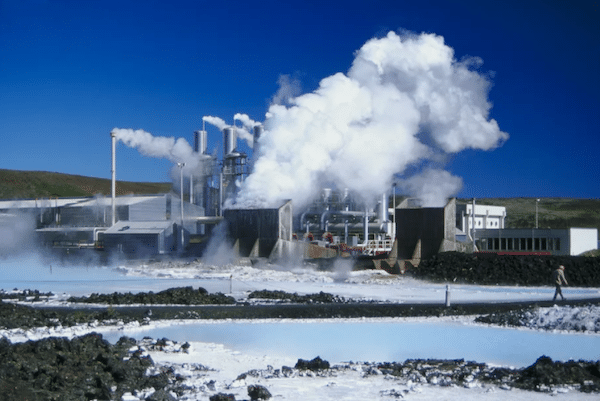
The Svartsengi power plant in Iceland was the first geothermal power plant in the world to combine generation of electricity and production of hot water for district heating. (Credit: Kirill Chernyshev/Shutterstock)
Geothermal green heating part of China’s decarbonization plans
Posted Jan 28, 2022 by China Dialogue
Originally published: China Dialogue (January 27, 2022 ) |
China is adopting geothermal because geothermal district heating is by far the most economic means of heating available … It also answers China’s fundamental policy of carbon neutrality and combating air pollution.
City of Xian geothermal district heating
The city of Xian’s geothermal district heating in Shaanxi Province China serves as an example of the country’s decarbonization plans.
China’s commitment that it would strive to peak its carbon dioxide emissions before 2030 and achieve carbon neutrality before 2060 has led a wide-ranging and profound economic and social transformation.
Various levels of government are adopting low-carbon policies tailored to local conditions, and industries are exploring their own green development paths, making concerted efforts to achieve the ambitious goals. This includes green heating, green power and green logistics.
For green heating, geothermal plays a specifically important role, as highlighted by the example of Xi’an, capital of northwest China’s Shaanxi Province. It was a freezing midwinter day in Xi’an, as Zhao Haiyan, 45, wore just a T-shirt and shorts at her home in Lintong, a suburban district of Xi’an as the temperature indoors reached 26 degrees Celsius.

The city of Xi’an’s geothermal district heating in Shaanxi Province, China , serves as an example of the country’s decarbonization plans.
Zhao lives in an affordable housing community of more than 400 households, which is equipped with Lintong’s first zero-carbon and zero-emission clean energy heating project and the first “geothermal+” new energy heating project. Residents were able to enjoy warm green winters as soon as they moved in back in 2018.
Home to the world-renowned terra-cotta warriors, Lintong and the surrounding area have rich geothermal resources. The geothermal heating technology applied in Zhao’s community has been updated to prevent any pollution of underground water reserves, said Wang Chao, director of the Lintong New Area Management Committee.
Statistics from the Shaanxi provincial government show that more than 100,000 households in its central plain area have enjoyed green and clean heating services, and the number is expected to reach at least 600,000 over the next few years, reducing the annual emission of carbon dioxide by 3.6 million tonnes than heating by burning coal.
Utilizing green energy has also brought additional financial benefits. “Based on the 70-square-km urban planning area of the Lintong New Area, comprehensive geothermal energy utilization is expected to create an annual income of about 8.7 billion yuan (about USD 1.37 billion),” said Wang.
China learns from Iceland’s expertise and experience
The geothermal district heating in the province has been developed with Icelandic support as part of Icelandic-Chinese joint venture Sinopec Green Energy Geothermal with the Icelandic partner Arctic Green Energy.
Reykjavik-based Arctic Green Energy is the leading exporter of the Icelandic success and leadership in geothermal to markets around the globe.
Learning from Iceland’s expertise and experience has helped Sinopec Green Energy Geothermal Development, become the world’s largest developer of projects that use underground geothermal energy to heat buildings.
Sinopec Green Energy Geothermal Developmentis is a joint venture between Arctic Green Energy, which owns 46 per cent, and state-owned oil and gas giant China Petrochemical Corporation (Sinopec Group), which owns the remaining 54 per cent.
Haukur Hardarson, chairman of Arctic Green Energy and vice-chairman of the joint venture is quoted by the South China Morning Post (SCMP) as saying:
China is adopting geothermal because geothermal district heating is by far the most economic means of heating available … It also answers China’s fundamental policy of carbon neutrality and combating air pollution.
– SCMP
Unlike fossil fuels, the supply of geothermal energy is highly reliable and is not exposed to volatilities of supply, fuel costs and transport capacity.
China has the world’s largest geothermal district heating network, which spans 200,000 kilometres of pipework and 9 billion square metres of floor space, according to the International Energy Agency. Low operating cost meant it was “very competitive” compared to coal-based heating in the long term.
Sources:
Thinkgeoenergy, January 11, 2022. arcticgreencorp.com
SCMP, 3 Sep, 2021. www.scmp.com
https://mronline.org/2022/01/28/geother ... ion-plans/

